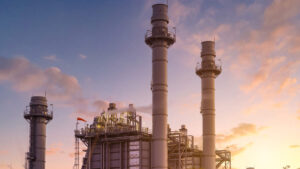Power Up: Gas shortfall warning sparks the usual frank exchange of opinions

Lines have been drawn in the sand as the gas shortfall debate resumes. Pic via Getty Images
The release of the 2024 Gas Statement of Opportunities by the Australian Energy Market Operator (AEMO) warning that time is running out on bringing on new gas supplies to meet demand has resulted in the usual flurry of claims and counterclaims.
In the report, the AEMO warned that from 2025 there would be risks of shortfalls on some days in winter in southern Australia under extreme peak demand conditions such as extreme weather driving demand for heating.
It noted that deep and shallow gas storage would be vital to meeting peak demand while providing seasonal flexibility.
The AEMO also said that northern gas producers would need to deliver anticipated supplies and would need to invest from 2026 in currently uncertain supply to meet domestic requirements and export positions.
This picture gets considerably worse as time goes on with potential for small seasonal supply gaps in each winter in southern Australia during 2026 and 2027 under sustained high gas usage conditions that will only increase in magnitude from 2028 as declining supplies outpace the decline in gas demand.
Unsurprisingly, the AEMO called for the development of currently uncertain new supply to be developed.
All the usual yahoos
As flagged at the beginning of the article, this unleashed the usual barrage of commentary from all spectrums of the political, environmental and business spheres.
The Coalition’s shadow minister for resources Susan McDonald pointed the finger at the Albanese Government, saying that Labor had not taken any steps to address the gas shortfall.
“Labor has failed to take any concrete action to solve the crisis, with no offshore petroleum acreage releases since August 2022 and still no clarity on what consultation requirement reforms the Government will deliver for offshore gas regulations,” she added.
Meanwhile, industry bodies Australian Energy Producers (AEP) and Australian Pipeline and Gas Association (APGA) called for urgent gas investment to meet demand from homes and businesses.
AEP chief executive Samantha McCulloch said Australia ran the risk of needing to use diesel – a higher emitting and more expensive fuel – to generate electricity because governments had stifled new gas projects with approval delays and compounding interventions.
“If gas supply from 2028 is to keep up with demand from homes and businesses, particularly for gas-powered electricity generation, then new investment is needed.”
Meanwhile, the APGA said that while gas infrastructure companies had made major investments to lift gas capacity, state and federal governments needed to provide policy support and prioritise vital infrastructure and supply projects.
“Governments must act to de-risk gas investments, which are essential if we are to close coal power stations and support intermittent renewables during the energy transition. For gas-powered generation, this means inclusion in the Capacity Investment Scheme,” APGA chief executive officer Steve Davies said.
The latter’s push for gas to be included in the Federal Government’s $67bn Capacity Investment Scheme is likely to raise the hackles of the green lobby as the scheme is aimed squarely at accelerating the development of renewable energy projects and battery storage to meet the need for clean dispatchable energy.
At the other end of the debate, Climate Solutions analyst Tom Quinn said that as one of the largest gas exporters in the world, it was ridiculous Australia didn’t ensure that enough gas is set aside for domestic users.
He called for exports should be limited during shortfall periods in order to protect local industry and households, adding that Australia’s energy security should not be held hostage by greedy gas exporters.
This was mirrored by Institute for Energy Economics and Financial Analysis energy finance analyst Kevin Morrison, who said there was actually no gas shortage in eastern Australia as three-quarters of the gas produced in the region is used as feedstock for LNG.
“There are several gas projects that are deferred or delayed that could still come onstream in the scenario of a shortfall in 2028, with Beach Energy’s (ASX:BPT) Enterprise and Thylacine fields, expected to get the go-ahead later this year,” he added.
“Comet Ridge’s (ASX:COI) anticipated Mahalo and Mahalo North developments are also other potential domestic supply options, as is Senex’s Atlas and Roma North expansions as well as APLNG’s Ironbark development.”
The hot take on gas supply
While the more extreme members of the green lobby will no doubt call for a stop on gas now, more level headed commentators realise that the current pace of transition to renewable energy and battery storage means that gas will be needed for some time to come.
Given that our ageing gas fields are very much in decline, we will certainly need new supplies in order to meet even declining demand and to power peaking gas plants that provide the grid with power during periods of peak demand.
The IEEFA has rather helpfully pointed out some potential new sources of gas though some of them require that development decisions be made soon if they are expected to provide more supply.
Additionally, the AEMO’s warning should really have the Federal Government ready to pull the trigger on the Australian Domestic Gas Security Mechanism, which allows the resources minister to restrict LNG exports when there is a reasonable prospect of a supply shortage in the domestic market.
Going nuclear?
Meanwhile, the Coalition continues to pin its hopes on nuclear power with opposition leader Peter Dutton calling for a “mature discussion” on the technology as an option to reduce emissions.
While this might sound very reasonable, he quicky moved to discredit the CSIRO’s GenCost report released in December last year that clearly estimated that even a proposed small modular reactor would still be more than three times more expensive than its wind and solar competitor in 2030.
Proof of this high cost comes from the lone SMR reactor in Utah, which was abandoned due to its lack of commercial viability despite the original promise that SMRs would offer a cheap way to generate nuclear energy due to being built through the wonders of mass production.
Given all the evidence indicating otherwise, the onus is now on the opposition to prove that nuclear energy can indeed be an affordable method of providing clean energy and I for one am looking forward keenly to their ability or inability to do so.
Related Topics

UNLOCK INSIGHTS
Discover the untold stories of emerging ASX stocks.
Daily news and expert analysis, it's free to subscribe.
By proceeding, you confirm you understand that we handle personal information in accordance with our Privacy Policy.








